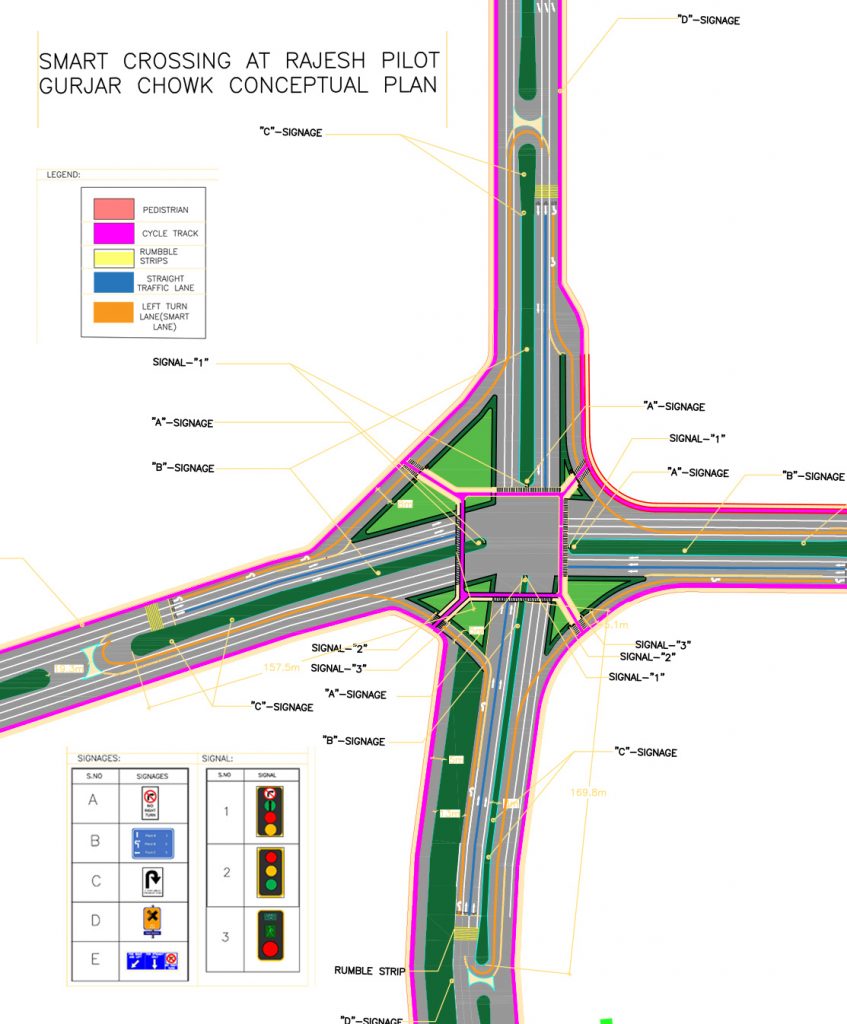To tackle the mammoth task of reducing traffic congestion and its harmful effects on the society, a patented concept called “Smart Crossing” by SmartUrbs came into existence. The initiative is focused on reducing traffic congestion, reducing the traffic queue length, reducing traffic pollution levels, and reducing commute waiting time at red lights while ensuring the safety of all commuters.
Smart Crossing is a traffic signal management design that converts a 4-phase crossing into a 2-phase crossing. This means that two lanes on opposite sides of a signal can operate simultaneously. However, vehicles can only move straight ahead or take a left turn. To take a right turn, they would have to turn left and make a U-turn. When the signal changes, they can move straight ahead. Studies on its efficacy have shown that Smart Crossing can reduce traffic congestions by up to 80%. Since two lanes can operate simultaneously, the number of signal changes at each junction is also reduced. This means that when a car moves from one signal to the next, the chances of getting a green light with SmartUrbs increases by 50%.
This article will speak about the design of the Smart Crossing plan by SmartUrbs for experimentation in design and modeling. The location selected was Rajesh Pilot Gurjar Chowk, Sector 61, Gurugram, Haryana, one of the mid-sized, busiest junctions in the city.
Objective:
- To quantify the impact of changing the geometry and traffic circulation scheme of a 4-way junction using the Custom Turns on traffic, with performance measures such as delays and queue lengths on junctions using a microsimulation model.
- To estimate the capacity of the junction with and without the Custom Turn scheme using a microsimulation model.
- To identify scenarios best suited to the implementation of Custom Turns in terms of traffic flow parameters such as volume and the geometry of the road.
Design Approach
The design of the Smart Crossing includes the implementation IRC (Indian Roads Congress) standards along with the patented idea. Intersections are a critical element of the road sections and should be designed in such a way that it minimizes the conflicts due to crossing, merging and diverting traffic. Intersections should be uniformly designed as per IRC standard and uniformity in design should be maintained as it is the key because even a newcomer in the area can anticipate what is expected at the intersections.
To maintain uniformity, intersection design included intersection, curves, vehicle turning paths and radius, super elevations, level shoulder width, speed change, lane lengths, channelization, and various types of signs and markings.
Let’s take a look at what features were included in the whole designing process.
Footpath
Footpaths were included in the design and were placed on both sides of the road, above the level of the carriageway separated by non-mountable kerbs. The width of the footpath was around 1.8 m to accommodate pedestrians during peak hours.
Pedestrian Guardrail
An important design element, the pedestrian guardrail was also added which would prevent indiscriminate crossing and stop people to get on the carriageway. It was strategically placed at hazardous locations such as junctions, schools, bus stops etc.
Pedestrian Crossing
The pedestrian crossing was included at places where vehicular traffic and pedestrian movement intersected. Zebra crossings were included for enhanced and guided movement of vehicle and pedestrian safety.
Island
The traffic islands are designed and retrofitted to match existing ground conditions and
manage the efficient movement of vehicular traffic.
Road Markings
New road and traffic markings were included in the design. Arrows were also painted on the carriageway which meant to give direction for the driver.
Signage
Signage is an important aspect of the design. Various traffic signages were placed strategically all over the junction in each and every arm as it would help commuters find the direction and aid in traffic movement. It makes the junction intuitive and facilitates the driver while maneuvering through the smart junction. The list of Signage are as follows:
- U-turn
- No Right turn
- Compulsory Left or Straight
- Stop Sign
- Pedestrian Crossing ahead
- Directional Sign Board
- Overhead Sign Board with Cantilever
- Overhead Sign Board
Since Smart Crossing is a new concept some custom signages were used. They are:
- Smart junction ahead
- For Right take left and U-turn
- Custom warning Message
Traffic Signals
There were three types of traffic signals used in this design.
- Dedicated traffic signal for left-turners,
- Dedicated signal for pedestrian and cyclist and
- Stop line signals on the main roads
Cycle Tracks
The design included a cycle track on either side of the road. The cycle track was designed with proper safety measures taken into account.
Rumble Stirps
The design also includes Rumble strips to slow down the traffic speed while crossing C Turn points.
Colour Strips
The design included colour stips to make the junction more intuitive. Colour stripes were used to separate the smart crossing lane and straight going traffic lane. Pink strips were used to indicate the cycle track, orange stripes were used to indicate the smart crossing lane and blue for straight moving vehicles.
This design of Smart Crossing comes bearing its own set of benefits such as:
- Can reduce the government’s cost of making flyovers for at least 10 years
- Eliminate traffic congestion at the junction
- Ensures the safety of commuters
- Reduces the waiting time at the junction
- Provides a cost-efficient solution
If the results of this design are to be believed, this concept reduced the congestion by up to 80% when compared to the existing system of road crossings.
Want to implement SmartUrbs in your city? Get in touch with us now!



